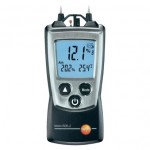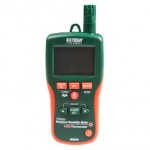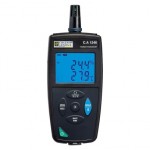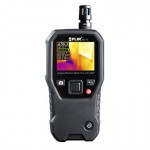In winter and spring the humidity increases around us; so now can be a good time to consider the importance of moisture meters and their various features.
Professional people use moisture meters to measure the moisture in walls, floors, concrete, hay and other materials, as even minor differences in moisture content can cause a big difference in the results of their work.
Just think about a lumber distributor; they must consider that wood absorbs and bleeds moisture until it is in balance with the moisture level of the environment. When wood is not properly acclimatized it will warp or crack.
If we think about farmers, the moisture content of hay in the field is critical because excessive moisture can trigger a reaction in the bale, causing it to heat it up and combust in the silo. To ensure accurate moisture measurements, moisture meters must be checked frequently and calibrated from time to time. Indeed for a certain purposes it is essential to use a specifically calibrated moisture meter in order to get the most accurate results.
There are two types of moisture meters which are commonly used:
1. Pin-type meters
2. Pinless meters
It is worth mentioning here that thermo-hygrometers, whilst not strictly moisture meters, can be used to check the humidity in a large area. Please see below for further details.
How do the pin-type meters work?
The pins of the meter are pushed into the material being checked. These meters then measure how much resistance there is to an electrical current to determine the moisture content of the material. As wood is a natural insulator and water is an electricity conductor, a low resistance will indicate the presence of moisture.
Advantages of pin-type meters:
• The two pins allow for testing both shell and core depths to measure the moisture present
• Readings are very reliable
• Replaceable pins are available
• Uneven surfaces can be measured easily
Disadvantages of pin-type meters:
• It measures only between the two pins
• Easily breakable pins
• Damages the surface leaving pinholes
Pin-type meters are ideal for contractors, restoration experts, woodworkers and many other professionals.
Please check out pin-type moisture meters.
How do the pinless meters work?
Pinless meters read the fluctuations of electromagnetic radio waves. They are designed for measuring the moisture content of wood and can be calibrated to certain wood species. When readings are taken on different species a correction chart must be used to get the proper result.
Advantages of pinless meters:
• Quick scanning of large areas, you just press the sensor plate onto the material, take the reading, lift and repeat the measurement
• As it is a quick and fast measuring process more results can be collected to calculate an average result
• These meters will not leave pinholes
Disadvantages of pinless meters:
• If the surface is too small or uneven there may not be enough space for the sensor plate
• Pinless meters scan only to a fixed depth, and if the material is too thin or too thick the pinless moisture meter cannot identify the source of moisture accurately
• Metal objects interfere with the electromagnetic radio waves sent out by a pinless meter
• Moisture on the surface of the material can alter the readings
Fast and easy to use, pinless moisture meters are great tools for restoration experts, flooring contractors and those who need to scan large areas very quickly.
Please check out our pinless moisture meters.
Thermo-hygrometers
Strictly speaking these instruments aren`t moisture meters, but they are important tools for restoration and woodworking professionals. These devices check the relative humidity and temperature of their immediate surroundings.
How do they work?
Thermo-hygrometers use a built-in sensor to get a reading of the moisture in the air.
Advantages of thermo-hygrometers:
• Ideal for measuring the relative humidity of a concrete slab in accordance with the ASTM F-2170-11 standard*
• Using this tester makes it very quick and effective to determine the general risk of mould growth in a moisture-affected structure
• Great equipment to determine the temperature and the relative humidity of the flooring
Disadvantages of thermo-hygrometers:
• Temperature changes may affect the results, especially at high humidity levels
• Every thermo-hygrometer has a built-in “ tolerance”, this means that there may be a difference between the reading taken and the actual humidity level
Please click here to find our thermo-hygrometer product range.
Thermal Imaging Moisture Meters
An alternative way to check for moisture is by using a thermal imaging camera. Although they do not work the same way as a moisture meters, they are very effective at detecting moisture. Thermal cameras work by looking at temperature and can provide a fast image giving you information about the moisture or mould damage of a property.
How do they work?
Thermography uses an infrared imaging and measurement camera to detect and measure the emitted thermal energy of an object. So where moisture is present the thermal image will show as cold spots on the camera.
Advantages of thermal imaging moisture meters:
• Its advanced features make possible to scan quickly large areas
• It is a non-invasive technology
• Speeds up the surveys with the automated humidity alarms
• Includes software to support creating report quickly
Disadvantages of thermal imaging moisture meters:
• When temperatures are very close in range, thermal cameras can lead to misreading information.
• It only allows to measure the surface temperature
These cameras are ideal for building restoration companies to inspect homes or properties comprehensively.
Take a look here at the latest thermal imaging moisture meters.
If you have any further question or if you would like to know more about moisture meters, please call our expert team on 01642 931 329, or visit our website to browse our full range of environmental testers.
*Standard test method for determining the relative humidity that is present in concrete floor slabs.






